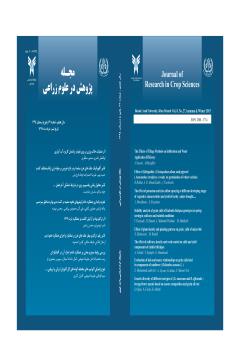تاثير آللوپاتيك علفهاي هرز سلمه تره (Chenopodium album) و تاج خروس (Amaranthus retroflexus) بر جوانه زني ارقام مختلف گندم
محورهای موضوعی : توليد محصولات زراعي
1 - دانش آموخته كارشناسي ارشد رشته كشاورزي – زراعت ، واحدتبریز ، دانشگاه آزاد اسلامي تبریز ، ايران
کلید واژه: نیتروژن, بور, عملکرد, چغندرقند,
چکیده مقاله :
به منظور بررسی تاثير آللوپاتيك علفهاي هرز سلمه تره (Chenopodium album) و تاج خروس (Amaranthus retroflexus) بر جوانه زني سه رقم گندم، آزمایشی به صورت طرح کاملاً تصادفی در شرایط گلخانه و آزمایشگاهی در 3 تکرار و با 3 فاکتور شامل ارقام گندم در سه سطح (امید، الوند و آذر2)، غلظت عصاره علفهرز در 3 سطح (شاهد، 5 درصد حجمی، 10 درصد حجمی ، 15 درصد حجمی)، نوع علف هرز در دو سطح (سلمه تره و تاج خروس) در سال زراعی 93-92 در آزمایشگاه مرکز تحقیقات و آموزش کشاورزی و منابع طبیعی آذربایجان شرقی به مورد اجرا گذاشته شد. نتایج حاصل از تجزیه واریانس صفات نشان داد که اثرات متقابل رقم در علف هرز بر روی صفات وزن تر ریشه چه و درصد جوانی، اثر متقابل رقم در عصاره بر روی صفات وزن تر ریشه چه، وزن تر برگچه، وزن خشک برگچه، طول ساقه چه و درصد جوانه زنی، اثر متقابل علف هرز در عصاره بر روی صفات وزن تر ریشه چه، وزن خشک ریشه چه و درصد جوانه زنی در سطح احتمال یک درصد معنیدار گردید. در بین ارقام مورد بررسی بیشترین تأثیرپذیری در کاهش وزن تر ریشه چه از عصاره 15 درصد حجمی عصاره علف هرز و رقم امید و به میزان 34/0 گرم به دست آمد. الوند و آذر2 در بین ارقام مورد بررسی متحملترین بودند که با رشد طولی 5/7 و 2/7 سانتی متر و رقم امید نسبت به غلظتهای بالای عصاره علف هرز حساسترین با رشد طولی 2/3 سانتی متر دیده شدند. از بین علفهای هرز مورد بررسی بیشترین تأثیر در کاهش رشد طولی و وزن خشک و تر گیاهچه از طریق علف هرز تاج خروس به میزان 45 درصد صورت گرفت. به طور کلی در مطالعه حاضر، نتایج حاصل حاکی از حساسیت بالای رقم امید نسبت به غلظتهای بالای عصاره علف هرز مخصوصاً علف هرز تاج خروس بود. رشد طولی تمامی ارقام در مواجهه با عصاره علف هرز به سبب وجود مواد آللوپاتی بطور قابل ملاحظهای محدود شد.
In order to evaluate the effect of allelopathic weeds (chenopodium album ) and pigweed (amaranthus retroflexus) on germination of wheat, an experiment, in a completely randomized design in laboratory conditions with 3 replications and 3 factors including wheat cultivars at three levels (omid, alvand and azar2 ), the concentration of weed in 3 levels (control, 5% by volume, 15% by volume), the type of weed on two levels ( weed and amaranth) in the 2013 – 14 cropping year was implemented in Tabriz ( Khosroshahr) research center on agriculture. The results of variant analyses showed that the interactions between cultivars on weed , on Rvs Ohat root fresh weight and percentage of germination, the interaction of the extract on the fresh weight of root and leaf fresh weight, dry weight of leaf, stem length and germination, interaction weed extract on root fresh weight, root dry weight and germination percentage was significant at the level of one percent. Among the investigated cultivars, the highest affectability in the reduction wet rootlet weight was the essence of %15 volume of the weed and omid variety in %34g. Among the investigated cultivars Azar and Alvand were the most tolerant which had the length growth of 7.5cm but Omid had 3.2cm length growth. Pigweed, among the weeds, had the highest effect in reduction of length growth, dry and wet eight of the plant ( 45 percent ). Omid variety had the highest sensitivity to the pigweed. Altogether, the length growth of all varieties, because of allelopathic materials, were considerably limited in exposing with the essence of weeds.
Bajwa, R., R., Khalid, and T., S., Cheema. 2003. Allelopathic activity of Allelophatic plants extracts 3: growth response of some pathogenic fungi to aqueous extracts of Bathenium hysterophorus. Pakistan Journal of plant pathology, 2(3): 145-156.
Chu, C.P.M., Ozbun, and R.D., Sweet.1978. Effects of temperature and competition on the establishment and growth of redroot pigweed and common lambesquarters. Crop. Sci. 18: 308–310.
Chung, I., M.K.H., Kim, J.K., Ahn, S.B., Lee, S.H., Kim. 2003. Comparison of allelopathic potential of rice leaves, straw, and hull extracts on Barnyard grass. Agronomy Journal.95:1063-1070.
Deneergard, A., and J., Porter. 2002. Allelopathy. Department of plant pathology, physiology and weed sciene.
Egbal, S., and T.J. Raith. 1999. Peramine alkaloid in neotyphodium infected Arizona Fescuse: Effects of endophtyte and host genotype and environment. Arizona State University. USA.
Labrada, R.1997. Problems related to the development of weed management in the developing world. FAO, Rome.
Narwal, S., R., Palaniraj, and S.C., Sati. 2005. Role of allelopathy in crop production. Herbologia. Vol. 6, No. 2.
Singh, H.P., D.R., Batish, and R., K., Kohli. 2006. Hand book of sustainable weed management. Food Products Press.
Storm, C. 2006. Agriculture history. ISSN:2-1482,Vol 80.
Szarnyas, I. 2000. Biology, Damage and possibilities of protection of some summer annual weeds. Annual mercury (Mercurias annual L.), redroot pigweed. Crop. Sci. 21: 108–110.
Waller, G.R. 2004. Allelopathy: Chemistry and mode of action of allelochemicals. Agronomy Journal, V. 55 (5), p, 542–630.
Zeinali, E. and S. M. R. Ehteshami. 2003. Biology and Control of Important Weed Species. Publication of Gorgan University of Agricultural Sciences and Natural Resources, Iran, 412p.


